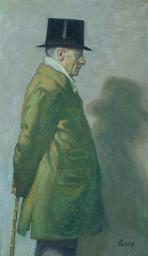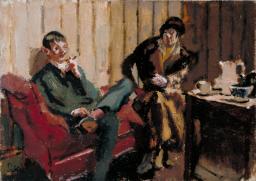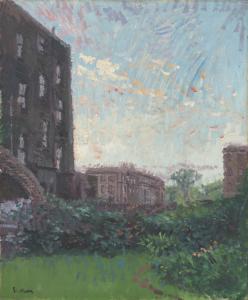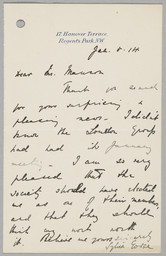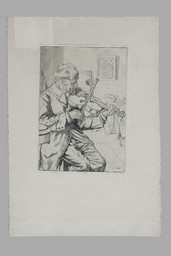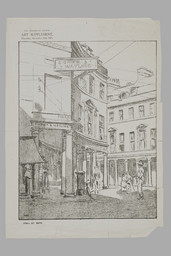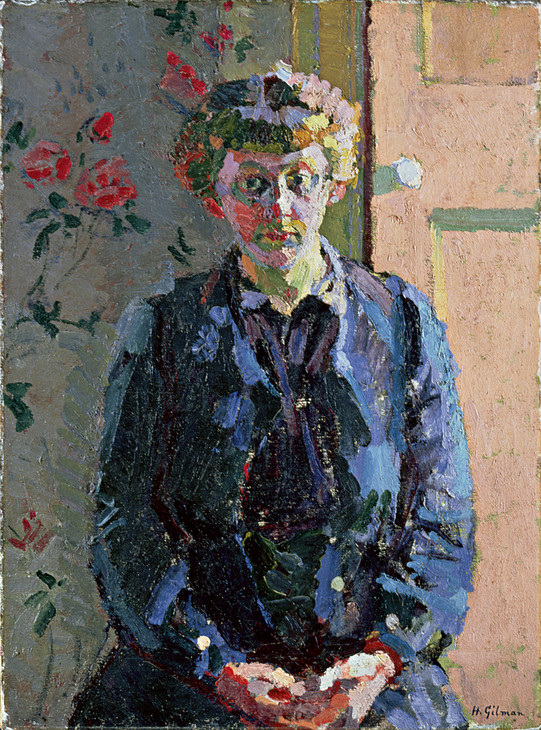
Harold Gilman 1876–1919
Sylvia Gosse 1913
Oil paint on canvas
690 x 510 mm
Southampton City Art Gallery
Photo © Southampton City Art Gallery, Hampshire, UK / The Bridgeman Art Library
Fig.1
Harold Gilman
Sylvia Gosse 1913
Southampton City Art Gallery
Photo © Southampton City Art Gallery, Hampshire, UK / The Bridgeman Art Library
Sylvia Gosse’s background was literary and artistic (fig.1). Born Laura Gosse on 14 February 1881, she was the youngest of three children of the poet, critic and librarian of the House of Lords, Edmund Gosse (1849–1928) and his wife Ellen Gosse (née Epps). Her mother and two of her aunts had all studied painting. Ellen (known as Nellie) had been a pupil of the painter Ford Madox Brown (1821–1893), while Ellen’s younger sister Laura studied with and later married the painter Sir Lawrence Alma-Tadema (1836–1912). While Sylvia was growing up there was a constant stream of distinguished visitors to the family house in Delamere Terrace, Paddington, and from 1901 in Hanover Terrace, Regent’s Park, including writers Henry James, Thomas Hardy, Robert Louis Stevenson and Rudyard Kipling. Later, the list of social acquaintances included the artist Walter Sickert, who became Sylvia’s lifelong friend and colleague.
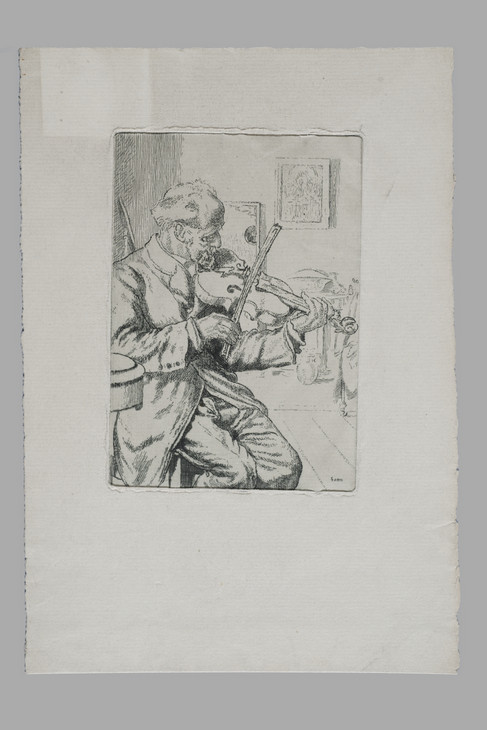
Sylvia Gosse 1881–1968
The Old Violinist c.1918–19
Etching 121 x 84 mm on paper 214 x 147 mm; plate-mark 122 x 85 mm
Inscribed by the artist 'Gosse' bottom right
Tate Archive TGA 8120/6/1
© Estate of Sylvia Gosse / The Bridgeman Art Library
Fig.2
Sylvia Gosse
The Old Violinist c.1918–19
Tate Archive TGA 8120/6/1
© Estate of Sylvia Gosse / The Bridgeman Art Library
Gosse always wanted to be an artist. Following schooling from the age of thirteen in France she studied at the St John’s Wood School of Art and from 1906 spent three years at the Royal Academy Schools. In 1908 her work was shown to Sickert who was impressed by the younger woman’s talent and in a typically dominant fashion decided the best thing would be for her to learn etching (see figs.2–3). She therefore began to attend Sickert’s evening classes at the Westminster School of Art and in 1909 went as a pupil to his new art school, which he ran with Madeline Knox at 209 Hampstead Road. The following year Knox left, owing to the stress of running the school while Sickert was ill,
1 and Gosse graduated from pupil to associate. She took over responsibility for the practical organisation and finances of the ‘Sickert and Gosse School of Painting and Etching’, now at 140 Hampstead Road, called Rowlandson House (see Tate
N05088), and she also taught the beginners and less talented students. Harold Gilman painted two portraits of her at Rowlandson House in 1912–13 (fig.1 and Cleveland Museum of Art, USA).
2 The school continued until 1914, and during this time Gosse’s own painting career also began to develop. She exhibited a domestic interior at the New English Art Club in 1911 and a portrait of her father at the Royal Academy Summer Exhibition in 1912. In 1913 she was elected to membership of the London Group (fig.4), with whom she showed work regularly until 1920, and in the same year she had her first individual show at the Carfax Gallery.
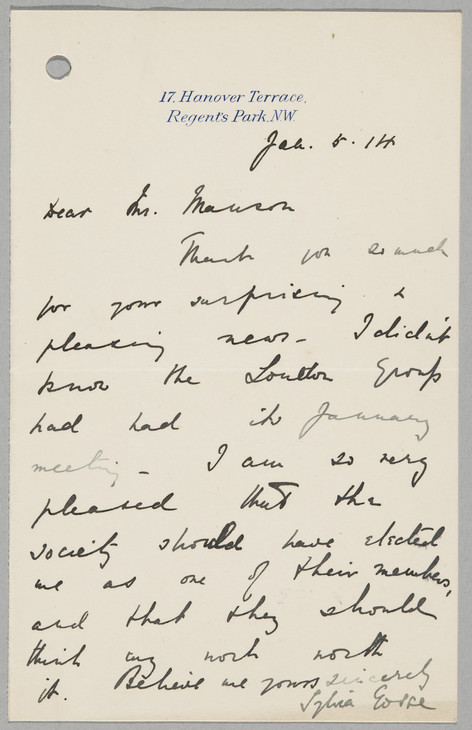
Sylvia Gosse 1881–1968
Letter to James Bolivar Manson 5 January 1914
Tate Archive TGA 806/10/6
© Estate of Sylvia Gosse / The Bridgeman Art Library
Fig.3
Sylvia Gosse
Letter to James Bolivar Manson 5 January 1914
Tate Archive TGA 806/10/6
© Estate of Sylvia Gosse / The Bridgeman Art Library
Although never a leading figure among the Fitzroy Street, Camden Town or London Group circle of artists, Gosse was nevertheless a constant and noted presence in the background of Camden Town life, working and living at a number of addresses in Fitzroy Street, Camden Town and Hampstead. She had independent means and remained unmarried. She was not by nature a sociable person and largely avoided participating in the activities of artistic groups or socialising with other artists. There were a few exceptions including Walter Taylor, the amiable Spencer Gore who seems to have been able to get on with everybody, and of course Sickert. Another of Sickert’s pupils, Marjorie Lilly, recalled that Gosse ‘might appear at Number 15 [Fitzroy Street] on At Home days, but rarely; being very shy, she always chose the most inconspicuous corner she could find, looking harassed and hunted, and hardly spoke’.
3 Despite her reserved nature Gosse supported her fellow artists where possible. In 1913 she made a gift to the Johannesburg Art Gallery, newly founded with a collection put together by the art dealer Hugh Lane, of paintings she owned by Walter Bayes, Sickert, Gilman and Gore.
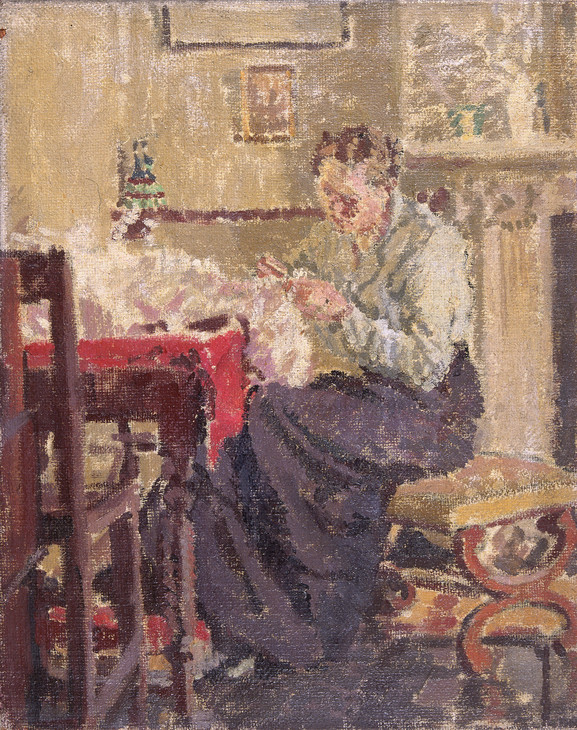
Sylvia Gosse 1881–1968
The Sempstress 1914
Oil paint on canvas
511 x 407 mm
National Museum of Wales, Cardiff
© Estate of Sylvia Gosse / Bridgeman Art Library
Photo © National Museum of Wales
Fig.4
Sylvia Gosse
The Sempstress 1914
National Museum of Wales, Cardiff
© Estate of Sylvia Gosse / Bridgeman Art Library
Photo © National Museum of Wales
The writer Evelyn Waugh once described Gosse’s paintings as ‘horrid – all iron bedsteads and Sickert’.
4 Certainly, Gosse’s shadowing of the elder artist is evident in her choice of subject matter, her painting style and her methods of working. She shared Sickert’s belief in the importance of draughtsmanship, and her paintings of domestic interiors (fig.5), street scenes and music halls were nearly always painted from squared-up preparatory drawings or photographs. The style of her paintings and etchings is at times difficult to distinguish from those of her mentor, and they frequently bear such Sickertian titles as
Camden Town Interior,
At the Music Hall or
Le Grand Duquesne and La Place Nationale, Dieppe. She was, however, a talented artist in her own right and the art historian Wendy Baron has argued that certain of Gosse’s individual artistic strengths had an influence on Sickert.
5 Contemporary critics frequently commented on the superficial likeness of her painting and etching to that of her teacher’s, but praised her ability to maintain her individuality. The critic of the
Times commented: ‘It would be easy to label Miss Gosse pupil of Walter Sickert. But these works show that she is much more than that – one can see the influence of the origin but Mr Sickert has not swamped her; he has only communicated to her some of his own virtues.’
6Throughout the 1920s and 1930s Gosse continued to exhibit widely at most of the best-known commercial galleries in London. In 1926 she was elected to membership of the Royal Society of Painter-Etchers and Engravers, and in 1930 also became a member of the Royal Society of British Artists. She also continued to support Sickert loyally until his death in 1942. In 1951 she moved to a bungalow in Ore, Hastings. There, according to her friend, Kathleen Fisher, she was happy to live out her later years away from the world, painting, visiting exhibitions and occasionally travelling abroad to the continent. She completed her last work in 1961, prevented from continuing to paint by eye cataracts. She died in 1968 aged eighty-seven. In 1975, Fisher published a collection of reminiscences about the artist. The book contains an extensive list of Gosse’s works that can be found in public museums and galleries. There are collections of her prints and drawings in the British Museum and the Ashmolean Museum, Oxford.





